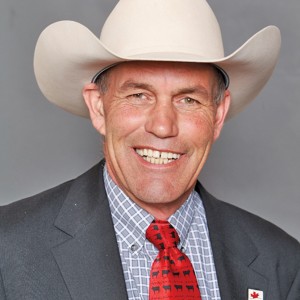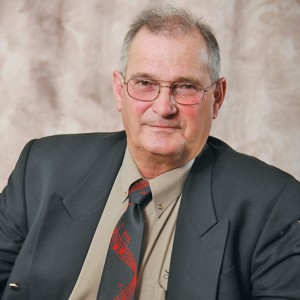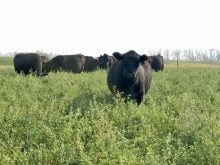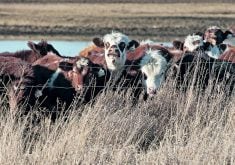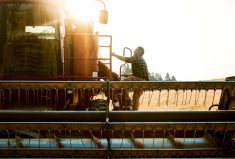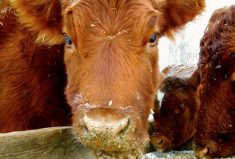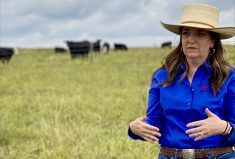Business gurus call them Big Hairy Audacious Goals — and now Canadian beef leaders have to figure out how to achieve the ones they’ve set for their industry.
“You have to pick a place to get to,” said Trevor Atchison, co-chair of the National Beef Strategic Planning Group. “You can’t make every goal in life, but if you don’t set something that’s higher than what you have today, you can’t strive to get there.”
The group, comprised of the country’s main beef industry players, released a document entitled Canada’s National Beef Strategy earlier this month. It sets the bar high with three specific goals to be achieved by 2020: Boost production efficiency by 15 per cent, increase carcass cut-out value by 15 per cent, and reduce cost disadvantage relative to global competitors by seven per cent.
“Maybe the goals are more ambitious than what we can complete, I don’t know,” said Atchison, a cow-calf producer and backgrounder from Pipestone, Man., who is also vice-chair of Canada Beef.
“But it’s in every producer’s best interest to try and get there to keep the industry healthy and grow it, with increased numbers that we’re going to need to maintain the market share for the global beef business we have today.”
The 30-page document (available for download at beefstrategy.com) contains many items that are long-term propositions, including improving genetics, forage productivity, and feed efficiency along with boosting technology transfer from researchers and utilizing better information flow in the value chain via BIXS 2.0.
The time is ripe
But a five-year time frame was chosen because by 2020, producers will be right in the middle of the average 10-year cattle cycle when prices will start to dip, said Atchison and his co-chair Martin Unrau.
“One of the highlights is that we’re all working together, looking at what we can do to remove some of the instability that we find in our industry at times when prices are low and people are trying to hold on,” said Unrau, also a Manitoba rancher and past president of the Canadian Cattlemen’s Association.
The CCA, Canada Beef, National Cattle Feeders’ Association, Canadian Beef Breeds Council, and Beef Cattle Research Council all support the strategy as well as Alberta Beef Producers and its sister organizations in the West, Ontario and the Maritimes. Members of the working group will meet at the end of this month to begin hammering out specifics on how to achieve the targets.
The joint effort is being hailed as an unprecedented show of co-operation in an industry often criticized for being fractured and inward looking.
“One of the highlights for me is that the strategy is so inclusive and all involved had significant input,” said Dave Solverson, current CCA president and Camrose-area rancher.
“I think this is historic for Alberta. In Alberta, politics have kept us from working together at times. So for me, this is a real positive.”
‘Impressive’ co-operation
That view is echoed by Dave Andrews, one of three members of the Straw Man Beef Initiative, which produced a landmark report a year ago calling for a sweeping overhaul of how the industry operates.
“This report has been something that has been needed,” said Andrews, who ranches near Brooks. “It’s impressive that these groups have come together and agreed on a strategy. Whether it is the right one or not remains to be seen, but it is well thought out and there is agreement — and that’s a big deal in this industry.”
The strategy addressed many recommendations of the straw man report, including a recommendation for a council of beef leaders.
“I’m encouraged and there’s some optimism with producers,” said Andrews. “I hope they’re successful in getting producers involved with their industry organizations and successful in moving forward to take the industry to the next level.”
Read Also

Milk concentration plant officially opens in Alta.
Canadian raw-milk processing history made with start up of Dairy Innovation West milk concentration plant in Alberta
He added he hopes producers will see the need to support the strategy with their checkoff dollars.
That will be critical, said Solverson.
“To remain competitive, we’re going to have to put more money into it,” he said.
Growth needed
Although the sharp rise in cattle prices has buoyed the industry over the past year, the legacy of a shrunken herd needs to be addressed, said Unrau, who ranches near MacGregor, Man.
“In all reality, the strategic plan is about economics and making sure our industry grows,” he said. “Right now our industry is a little too small to maintain some of the infrastructure we have.”
The time is ripe for bold thinking and taking action, said Atchison.
“We’re at a point of change in the cattle industry,” he said. “People are looking to the future, and are anxious to take on something new and learn something new.
“We’re hoping that this will work with the strategy to get new ideas flowing quicker because people will be looking and hungry for it.”
And even though the targets are ambitious, they are achievable, said Solverson.
“There’s all kinds of room in innovation and production practices that can improve our overall profitability and sustainability,” he said.
“The industry leadership has come into the room together and come up with solutions,” added Andrews. “That’s what they seem to be trying to achieve with this report and I support them 100 per cent with that.”





